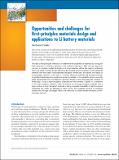Opportunities and challenges for first-principles materials design and applications to Li battery materials
Author(s)
Ceder, Gerbrand
DownloadCeder_Opportunities and challenges.pdf (1.025Mb)
PUBLISHER_POLICY
Publisher Policy
Article is made available in accordance with the publisher's policy and may be subject to US copyright law. Please refer to the publisher's site for terms of use.
Terms of use
Metadata
Show full item recordAbstract
The idea of first-principles methods is to determine the properties of materials by solving the basic equations of quantum mechanics and statistical mechanics. With such an approach, one can, in principle, predict the behavior of novel materials without the need to synthesize them and create a virtual design laboratory. By showing several examples of new electrode materials that have been computationally designed, synthesized, and tested, the impact of first-principles methods in the field of Li battery electrode materials will be demonstrated. A significant advantage of computational property prediction is its scalability, which is currently being implemented into the Materials Genome Project at the Massachusetts Institute of Technology. Using a high-throughput computational environment, coupled to a database of all known inorganic materials, basic information on all known inorganic materials and a large number of novel “designed” materials is being computed. Scalability of high-throughput computing can easily be extended to reach across the complete universe of inorganic compounds, although challenges need to be overcome to further enable the impact of first-principles methods.
Date issued
2010-09Department
Massachusetts Institute of Technology. Department of Materials Science and EngineeringJournal
MRS Bulletin
Publisher
Cambridge University Press (Materials Research Society)
Citation
Ceder, Gerbrand. Opportunities and Challenges for First-principles Materials Design and Applications to Li Battery Materials. MRS Bulletin 35, no. 09 (September 31, 2010): 693-701. © Cambridge University Press 2013
Version: Final published version
ISSN
0883-7694
1938-1425